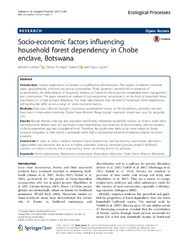| dc.contributor.author | Garekae, Hesekia | |
| dc.contributor.author | Thakadu, Olekae Tsompie | |
| dc.contributor.author | Lepetu, Joyce | |
| dc.date.accessioned | 2022-11-22T13:13:11Z | |
| dc.date.available | 2022-11-22T13:13:11Z | |
| dc.date.issued | 2017 | |
| dc.identifier.citation | Lepetu, J., Garekae, H., & Thakadu, O. T. (2017). Socio-economic factors influencing household forest dependency in Chobe enclave, 6Botswana.Ecological Processes, 6:40 | en_US |
| dc.identifier.issn | 2192-1709 | |
| dc.identifier.uri | 10.1186/s13717-017-0107-3 | |
| dc.identifier.uri | http://www.ecologicalprocesses.com/ | |
| dc.identifier.uri | https://hdl.handle.net/13049/590 | |
| dc.description | This article is distributed under the terms of the Creative Commons Attribution 4.0
International License (http://creativecommons.org/licenses/by/4.0/), which permits unrestricted use, distribution, and
reproduction in any medium, provided you give appropriate credit to the original author(s) and the source, provide a link to
the Creative Commons license, and indicate if changes were made. | en_US |
| dc.description.abstract | Introduction: Human dependence on forests is a multifaceted phenomenon. The degree of reliance on forests varies geographically, overtime and across communities. These dynamics underpin the importance of understanding the determinants of household reliance on forests for the long-term sustainable forest management and conservation. This paper presents an analysis of socio-economic determinants on the level of household forest dependency in Chobe enclave, Botswana. The study hypothesised that the level of household forest dependency will significantly differ across a range of socio-economic factors.
Methods: Data was collected through a structured questionnaire survey of 183 households, randomly selected from three communities bordering Chobe Forest Reserve. Binary logistic regression model was used for analysing data.
Results: Results showed that age and education significantly influenced household reliance on forests, while other socio-economic factors were not significant. Forest dependency was observed to be decreasing with an increase on both respondent age and educational level. Therefore, the youth were likely to be more reliant on forest products compared to their elderly counterpart while higher educational attainment lessened reliance on forest products.
Conclusion: In order to foster a balance between forest dependency and biodiversity conservation, alternative opportunities and provision and access to higher education aimed at diversifying young people’s livelihood activities are vital in reducing forest dependency, hence protecting forests for posterity. | en_US |
| dc.language.iso | en | en_US |
| dc.publisher | Springer Open | en_US |
| dc.relation.ispartofseries | Botswana.Ecological Processes;6:40 | |
| dc.subject | Forest dependency | en_US |
| dc.subject | Biodiversity conservation | en_US |
| dc.subject | Rural-urban migration | en_US |
| dc.subject | Chobe Forest Reserve | en_US |
| dc.subject | Botswana | en_US |
| dc.title | Socio-economic factors influencing household forest dependency in Chobe enclave, Botswana. | en_US |
| dc.type | Article | en_US |

